
Bamboo
I came across a bamboo wok cleaner at a Chinese supermarket in Haymarket, Sydney. The bamboo is shredded and makes a crispy, crackling, grinding sound. The sound world of the bamboo relates to a scene in the performance video where a tree is constantly falling and rising back up again. Here the performer acts like a Foley artist as the crackling of the bamboo relates to the crackling bark from the tree. This happens in real-time but the performer cannot see the tree so at times it seems disconnected. The performer twists and turns the bamboo on top of a piece of paper, which lies across the low strings, rattling against the strings when struck. The result is a rich timbral world with a dynamic percussive quality as it jolts, stutters and rolls around the sections of the piano.

Electric Fan
An electric fan with soft nylon string attached to each blade creates a soft sustaining resonance. The fan slowly glides over and sonically unveils each string, and sections, of the piano, such as high tinny sounds beyond the bridge and around the tuning pegs.
Wooden Mallet
A wooden mallet scrapes and grinds over the strings, the metal plate and wooden case of the piano. Its rough surface creates varying sounds depending on the angle it is held and the location it is played. The instructions in the score for the use of the wooden mallet are: “Let the weight of the mallet determine the pressure on the piano and its strings rather than applying additional pressure”. The performer is also to copy the man’s hand orientation shown in the video score.
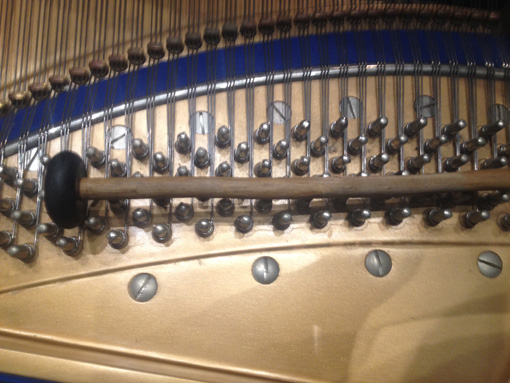
Rubber Mallet
A rubber mallet is used to strike the central stress bars on the piano. The sharp attack causes the metal plate to vibrate suddenly producing an after-glow of overtones from the strings. Here the performer is hitting the stress bar at the same time a man in the video is hitting hard rock with a rock-pick, which is a process for harvesting minerals from the land. Although these tools may seem damaging to some piano enthusiasts, a lot of care taken not to harm the instrument.
Experimentation Of Tools, Video as Process
In the process of creating the work I made a series of video recordings of my explorations on the piano. Here I could play around with various objects and explore the regions of the piano with these implements. These ideas were documented as videos so I could refer back to them during the later stages of the compositional process. I was doing this before I found the archival footage. I compiled these videos on a website and it became part of the poetic impetus for my musical ideas. These recordings were like meditations using shapes and movements repeated over and over in different permutations with varying tools. The shapes I explored were:

I wrote in my process diary at this time: “the inside of the piano is a terrain. The strings are a body awoken through a drama of surface tensions and colouring through materials”. This reflects a particular way of seeing the instrument that allowed me to work from my own discoveries rather than drawing from methods of other composers. Upon discovering the archival footage, my ideas fell into place. I made sure to choose my own tools used inside the piano, selecting ones that I thought sounded interesting to me that complemented the conceptual focus of the work.
Audio on Earphones
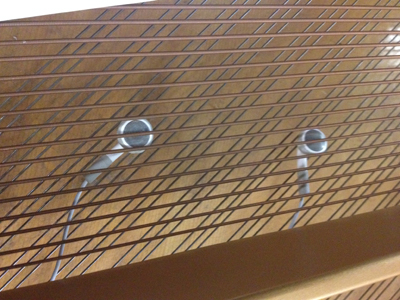
Audio from the archival footage plays through earphones, which sit in between the strings.
Conceptual Piano Keyboard Note Choice
There are sections of the piece in which fragments of appropriated music are played upon the piano keyboard (Zone 9). This happens at timecodes: 1’00”, 1’14”, 2’23”, 2’28”, 3’48” in the video score. This material is a distilled reworking of music used in the archival footage, written by the late Australian composer Robert Hughes. The timing of the notes remains the same as the original but, via transcription, certain notes and phrases have been removed, leaving behind only a trace; erasing and fading the driving lyrical trajectory of the original music. It is then reappropriated to soundtrack new arrangements of footage and visual stimuli. The preparations inside the piano do not affect the timbre in the middle register, so the performer plays these fragments in this region.
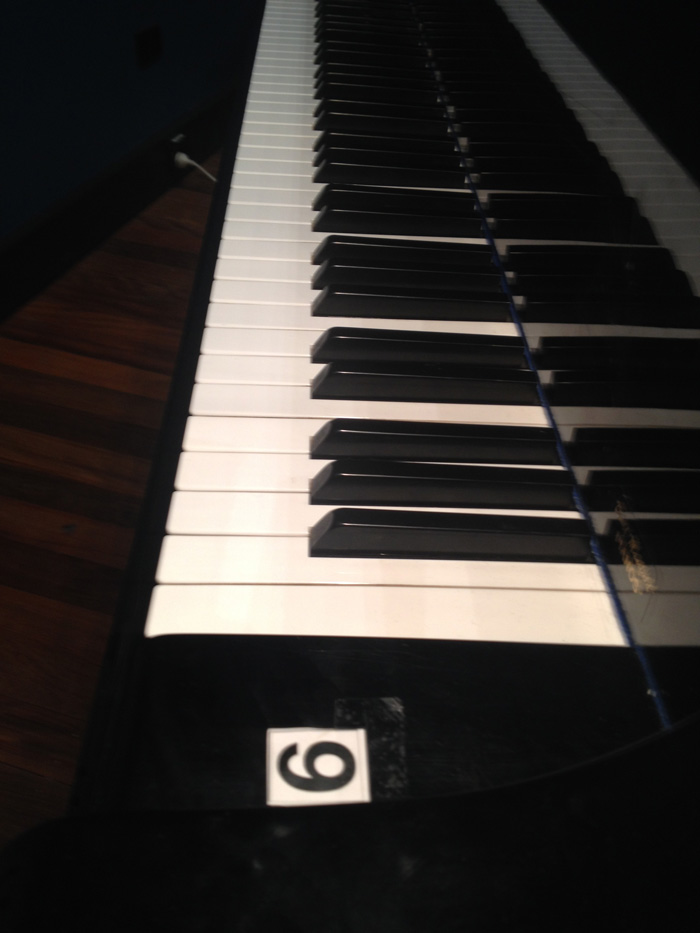
Tools
Tools and Sound Worlds
The traces of the engraving process in the archival video are performed with varying tools such as: an electric fan, shredded bamboo, and rubber and wooden mallets.
Lapel Microphone
Use of Electronics: Lapel Microphone
The performer has a small-capsuled lapel microphone (DPA 4061) attached to their left hand, which is amplified through loudspeakers. Text instructions in the video score indicate when to wave the mic over the current sound being made. The original audio from the archival video plays through earphones placed inside the piano and is amplified by the lapel mic when the performer waves it over them at different rates.
Lapel Microphone: Score Instructions
The performer has six instructions for how to move the lapel microphone over the piano, displayed as text in the video score:
- Follow (follow where the other hand is moving and the sound it is creating).
- Off (take mic away).
- Wave l Fast Object (wave mic quickly towards and away from the object making sound).
- Wave 2 Slow Object (wave mic slowly towards and away from the object making sound).
- Wave 1 Fast Earphones (wave mic quickly towards and away from the earphones).
- Wave 2 Slow Earphones (wave mic slowly towards and away from the earphones).
A precise notation of what ‘fast’ and ‘slow’ means is provided to the performer. This is seen below as a score, which the performer becomes familiar with. 1 is ‘fast’ and 2 is the ‘slow’ movements by the left hand:
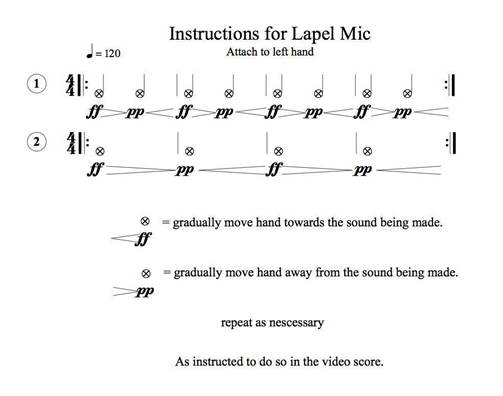
Lapel Microphone: Conceptual Relationship
Live, physical movement of the lapel mics is used as a way to cut up the amplification of the sounds produced, allowing the possibility to play with the difference between close miking and the acoustic sound in a dynamic way. Conceptually, an analogy was drawn between the waving of the lapel mic and the hovering of the planes that fly over and survey the land, found in the archival footage (although not featured in the performance video). This connection connects the piece to cartography practices more generally. An aural relationship to this concept is also present when the electric fan makes contact with the paper used as a preparation, creating sounds like the propellers on a plane.
Performer
Performer’s Perspective
There was some uncertainty from the pianist, Tamara, as to whether or not the engraver in the archive footage was actually touching the surface at a particular point, or whether the man’s pencil was touching the map. These were differences of opinion that are the result of working with a medium like video, which differs with how a line might be identified and used in tablature notation. Tamara discusses further about working with video as a score in an interview after our studio recording. Tamara explains:
In the piece (Mapping Australia), you can’t just by memory create the sounds of what’s on the screen, you actually have to really look at the screen because you have to do it at exactly the same time and that means there’s a lot of precision involved so that's the hardest part about it. You know, even if you were counting in a piece or you’re in a certain tempo there’s a tiny bit of leeway there, you can have a tiny bit of rubato or ease into something. But in this case you can’t.
(Cislowska, 2014, Audio Interview)
The rigidity of time described here, along with the independent left and right hand movements, and the eyes needing to dart from one place to another, made things difficult for Tamara (or any performer). A solution we came up with was to be economical with the tools. For instance, we found a rubber mallet, which doubled up as a wooden mallet on the reverse end. We also decided to keep all notated elements in one place so the performer’s head remains in one position.
The Piano
Practical Aspects: Zones, Topography and its Political Associations
The piano is broken up into 13 different zones, much like how land is divided into areas. The piano is not divided up by its notes or corresponding strings, but by space. Dividing lines are drawn based on visual aspects, such as where the stress bars are, or where the bridge starts, to determine the separation of zones. The composition was therefore constructed based on the physical properties of the instrument.
On the surface, this can be compared to the history of the land divisions on the map of Australia. The following map shows the aboriginal languages, clans, groups of people and dialects across Australia.
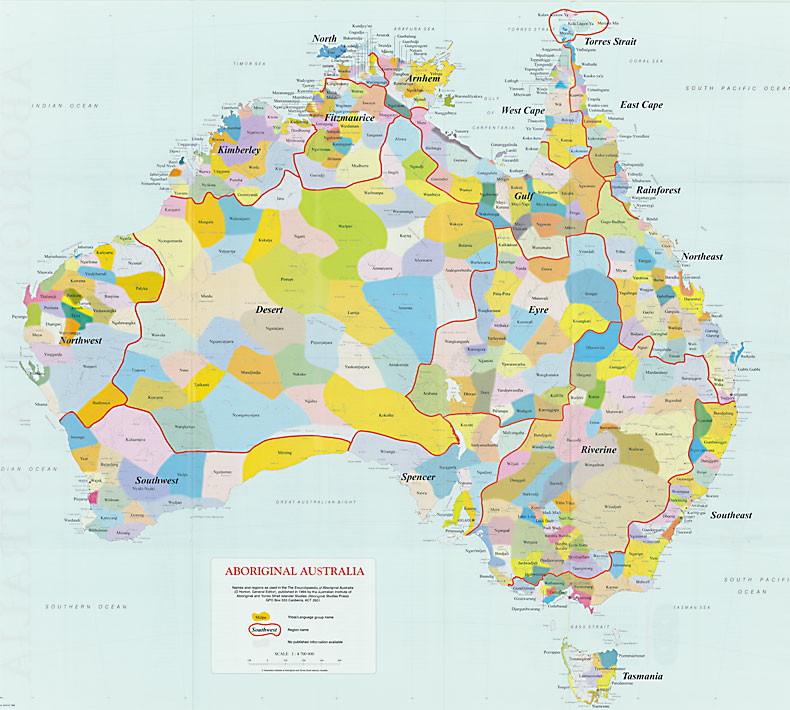
Here is a time line of events showing the formation of more recent colonies/states and mainland territories.
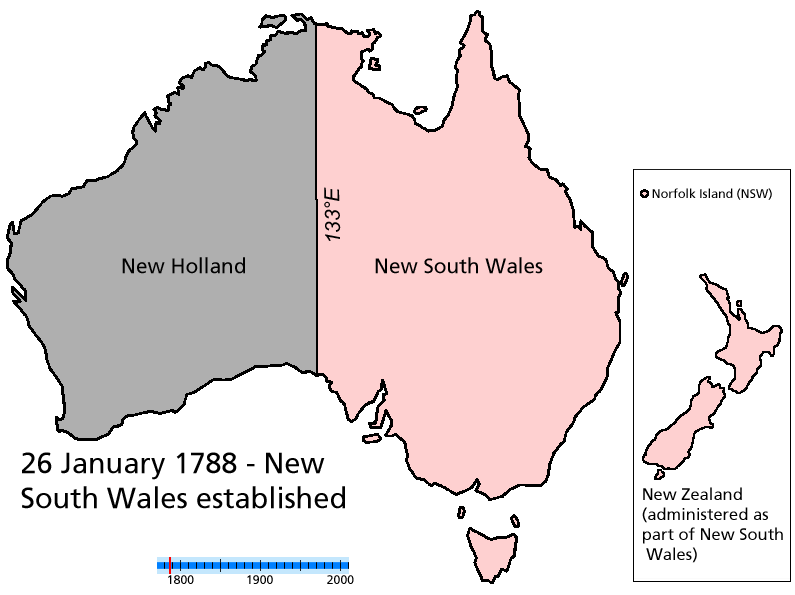
And here are the divisions I made on the piano for my piece.
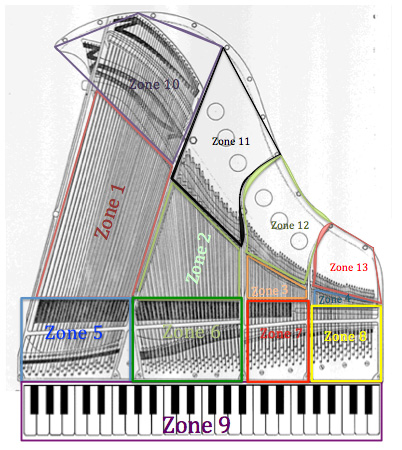
The video score instructs which zones to perform in, and the performer must move there and perform the action they see in the video score. The video on screen is to be scaled to the relative size of the zone. The instruction is to imagine that the video screen is stretched and morphed to the shape of that given zone.
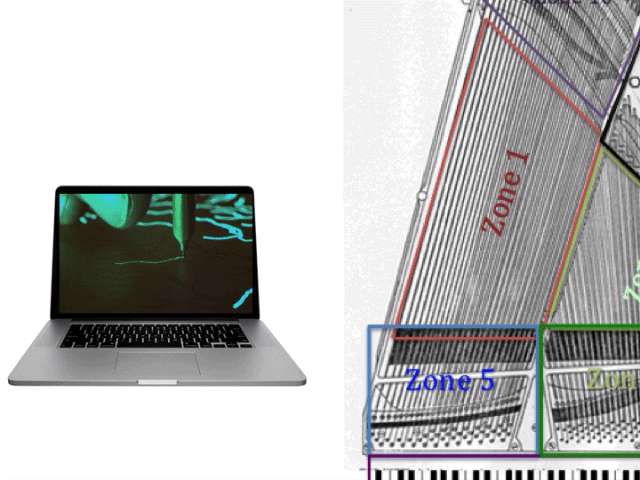
The exact proportions are to be estimated. The jagged terrain lines in the video are traced onto the rough and unstable surface of the piano strings, sonically activating the particular zone.
Archival Footage: Political Reading Applied To The Piano
In the context of the documentary, it appears as if the cartographer’s role of objectively representing the landscape is analogous to the government’s disconnection to the people and culture. I was interested in applying this perspective to the piano. In my work, there is a misrepresentation of the piano, as if the piano’s history and its conventions have been disregarded. A sense of loss is found in the archival video, in the process of trying to quantify something as complex as the natural world. So, in the performance, the performer quantifies the movements of a select number of fragments from the archival video. The piano also has analogous connections to landscape, a map, and to the cartographers’ mapping practices.
MAPPING AUSTRALIA
by Daniel Portelli
Short Description
This project, Mapping Australia (2014), presents my recent compositional interests in working with multimedia, presence, the conceptual and the kinesthetic in the development of new music performance and notational systems. It is a political work based on archival footage from 1966. The footage is about Australia's map-making processes but it also advertises Australia for foreign mining interests. I disagreed with what the footage represented and wanted to counter the self-importance and authority of the video. I turned movements from the people in the video into movements by the pianist inside the piano. The piano conceptually represents land and is mapped and notated in a spatial-choreographical manner, fused with my own musical ways of thinking about composition. The resulting sound is gritty, grinding, scraping, brushing and knocking sounds. The performer is asked to mimic silly movements in the video in an attempt to mock the source material – I also created humorous video manipulations to go along with the performance. The notes played on the keyboard are a distilled reworking of the music by the late Australian composer Robert Hughes (the music used in the archival footage). By removing certain notes and phrases I left behind only a trace of the driving lyrical trajectory of the music.
Introduction to the Work
I was invited to write a transmedia piano work for Australian performer Tamara Anna Cislowska and for the Music Now Symposium at the University of Western Sydney. I was interested in exploring ways of interacting with video as a score and devised methods for imitating on-screen actions, turning them into a formalised system of gestures on the piano. I also made video documentation of myself performing these imitations, which became a series of instructional videos for the performer. The details have been published on my website. Mapping Australia has been performed live and recorded in a studio by Cislowska as well as being erformed by Australian pianist Gabriella Smart from Soundstream Collective, Adelaide. This information is intended to provide a refection of the processes behind the work, its practical aspects as well its conceptual underpinning.
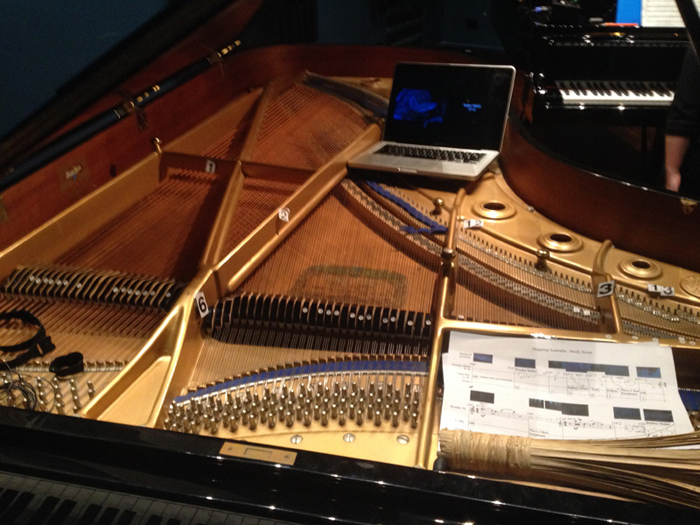
Study Score
Actions in the video are reduced down to lines in a ‘study score’ I made (see below) and turned into functional musical data to be interpreted by the performer. The ‘study score’ is something I developed to accompany the video score. It is a notation of instructional details drawn from the video score and put on paper into a timeline. The lines on the score show the direction, shape and relative spacing of each gesture in the video score. By using the ‘study score’ the performer can have an overview of the macrostructure and get a sense of the ordering of sequences and how long tools are used for, an aspect which is difficult to represent in the moment-to-moment events of a video score.
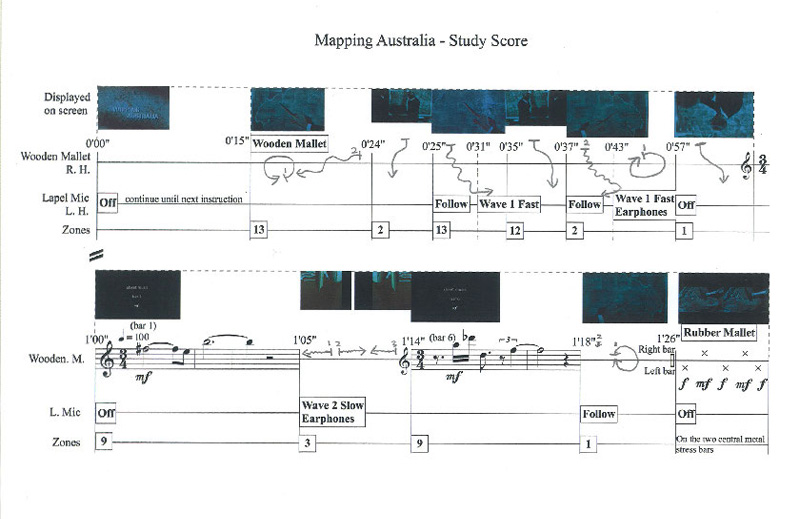
CARTOGRAPHY
Cartography, Philosophy And The Use of Lines in Composition
The process for developing the piano instructions and use of tools has a relationship to the cartographic engraving practices in the 1960s, which used light to create precise terrain lines. The video screen displaying the video score is a transference from light to physicality, whereas the topographic process is from physicality to light:
The plastic sheets are taken one at a time and placed on a light table, where a soft light shines up through a white plastic surface. This illumination from below makes the lines of the map manuscript visible through the scribecoat. An engraver carefully cuts away the scribecoat along the lines and areas that are to be a certain colour on the finished map. For example, one sheet will have all the lines for rivers, lakes, and other bodies of water that are to be blue.
(“Topographical Maps,” website)
I am interested in the reductionism that occurs as a result of the line, and the philosophical inquiries that can be drawn from that; such as turning a river into a functional representation, for example as a blue line, versus experiencing and sensing a river for qualities such as the sense of tranquility that occurs through being amongst the constant presence of a flowing stream, listening, sensing and contemplating its fluidity, its mirroring surface, its texture, its motion, its life-giving properties, its cultural or sacred significance, or religious symbolism. So in this piano performance, the map, the score and the video are all representations of something else and mediators of reality. There is also a distancing going on, where there is no clear or immediate way of understanding all the elements in the piece. In other words, it is allusive. The non-grid like structure of the piece gives a sense of flowing sounds, with unstable metric divisions. The surfaces and textures of the piano and the tools used are important features when listening to the piece. I was trying to create a multi-sensory experience based on the archival video.
Live Camera Feed: Audio Score
The camera points inside the piano and follows the performer’s hand movements according to pre-recorded verbal instructions delivered via headphones. The instructions for handheld camera include:
‘Follow Left’ – Follow the left hand of the performer
‘
Follow Right’ – Follow the right hand of the performer
‘
Be Still’ – Keep the camera still
‘Zoom To Close-Up’
‘Zoom To Wide Shot’
‘Blur’ – Unfocus the image
‘Focus’ – Focus the image
‘Handheld’ – Create a shaky hand held motion
I am interested in the concept of ‘trace’ and how the archival footage can be transformed through retracing. Here the camera is tracing the pianist's movements who is, in a sense, tracing the archival video.
ARCHIVAL FOOTAGE - Mapping Australia (1966)
Discovering Archival Footage As A Score
The archival footage used in this piece was made in 1966 by the Australian Commonwealth Film Unit Production for the Department of National Development (“Internet Archive” 1966). The video shows methods used by cartographers in Australia at the time and advertises Australia for foreign mining interests. The Indigenous Australian perspective on land and culture is not represented nor is there any acknowledgement of Aboriginal land rights, so this politically motivated me put the work together. I used fragments from the video as score material, such as a scene where a man moves his pencil around on a map in an arbitrary way, a rock-pick hitting hard rock in the search for minerals in the earth, and terrain lines being drawn on plastic surface.
My political response to the archival footage became the framework, which led me to make decisions on how to represent the video, the map, and the piano. This led me to rethink how the piano can be mapped, not just by its notes, register or strings, but by thinking of other methods like through visual or tactile things like colour, lines, shapes, contours, surface textures and spatial dimensions within the piano. By rethinking how the piano is represented it helped to open up how it was used, notated, listened to and perceived.
There is a tradition of geographical research (e.g. Gould and White, 1974) which sets out from the premise that we are all cartographers in our daily lives, and that we use our bodies as the surveyor uses his instruments, to register a sensory input from multiple points of observation, which is then processed by our intelligence into an image which we carry around with us, like a map in our heads, wherever we go. (Ingold, 1993 p. 124)
VIDEO SCORE
How The Video Functions As A Musical Score
Sections from an archival video (Mapping Australia, 1966) are cut up into sequences for the performer to act out, for instance, mimicking the movement of a person’s hand from the video. Text instructions are overlaid on the video that inform where on the piano to perform the gesture and with which object, such as a mallet or bamboo. The video score is displayed on a laptop inside the piano, which the performer reads during the performance.
As a score, the archival footage contains clear close-up scenes of people working with maps, tracing lines, close-ups of moving lines, and pencils moving across the terrains of maps, which a performer can imitate by tracing these movements onto the surface of the instrument.
The archival film footage is used as the basis for the score. A direct relationship is made between the position of the line on the screen and the line to be drawn in the piano. The footage is therefore cut up and moved around in the frame and the performer follows it. My video editing choices were determined by practice videos I made earlier, documenting my experiences working with the piano. So I knew arranging the archival video a certain way would lead to a particular aural outcome. This led me to arrange the video as I would a musical composition.
The footage of lines being drawn on maps was ideal to ask a performer to follow. It was more versatile than other video content I worked with. It meant I could give instructions to the performer and there was more agreement about the identification and function of the line; the start and end point, its movement, its position in the frame. It also has visual representations of a past, present and future, so the performer could somewhat predict the next move. The lines were clear and the shots were long. This also meant I could time-stretch them over long periods of time and manipulate the footage and compose with the movements of the lines. It also has visual cues to indicate that a gesture is about to be made, such as a shot where a rock-pick is raised into the air before it strikes, and when it does strike the performer has to strike the piano with a mallet at the same time. This reminded me of a conductor waving a baton in the air to indicate the upcoming down beat.
Political Choices As Compositional Process
I was initially drawn to the low end of the piano. I was fascinated by the rich, full-bodied sounds that were produced. My earlier practice videos I filmed reflect this tendency. This is seen in a video entitled single gestures with resonance, containing a collage of ideas surrounding this notion. This is one video among many videos I made leading up to the final work.
Later I decided to resist the urge to work mainly in the low-end section of the piano. Because I was seeing the piano as a representation of the map of Australia I did not want to prioritise just one area. From the political perspective I attached to the work, it seemed narrow-minded to do this, and this narrow-mindedness is something I disliked about the archival video. Instead, I chose to distribute the activity somewhat evenly around the piano. This forced me to go against my intuition and explore new ideas. The first section of the piece starts in Zone 13 and begins with a wooden mallet on the metal frame. Sections of the video are sped up and slowed down to control the pace of each gesture as a transformation of sonic material. The images are also flipped and moved around to change its direction and position. I treated video fragments in motivic ways akin to musical permutations, transforming them through transposition, inversion and retrograde.
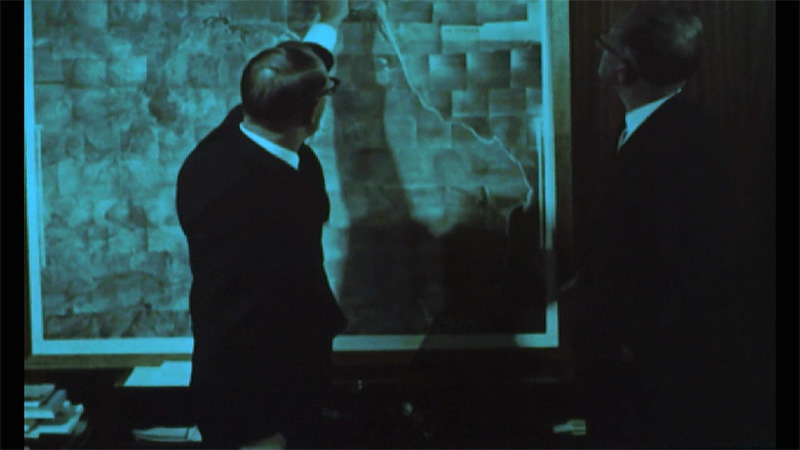
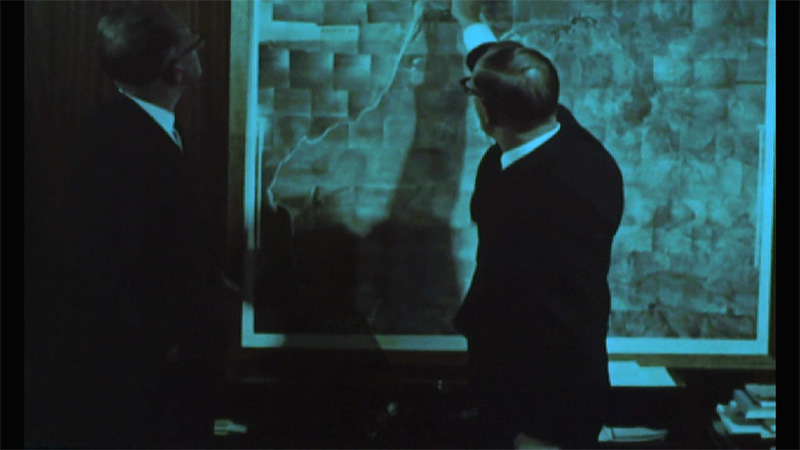
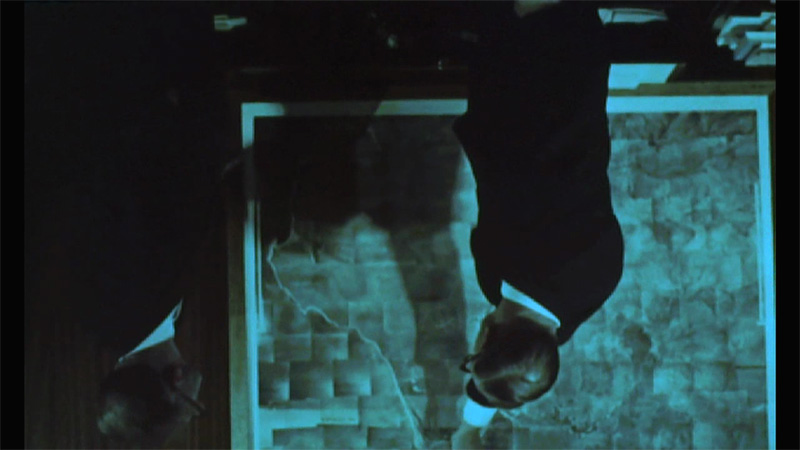
A motif in the video score where the pianist has to follow the man’s pencil:
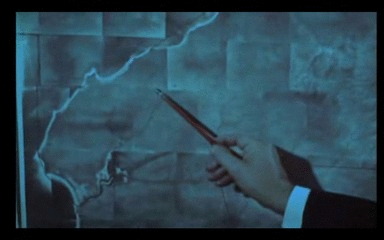
Video As Notational Instructions
The video score comes with three instructional videos, which are to be used to learn about the relationship between the video score content and how to apply it to the piano. The instructional videos are given to the performer as part of a website containing all the performance materials I have discussed in this paper. The instructional videos (shown below) are presented as score instructions on a website and the performer must become familiar with it to understand the mechanics of the video score. This method was effective in communicating unique methods I developed myself in an efficient way. The three videos explain how to read the video score, along with video examples of me doing a demonstration on the piano.
For ‘Wooden Mallet – Pencil On Map’ the instruction to be acted upon in response to the video score is: Make contact with piano using the wooden mallet when the man’s pencil touches the map. Copy the movement of the pencil and hand orientation as it moves along the map, as well as its position in the frame of the video. Alternate between the two or do one or the other.
For ‘Rubber Mallet On Stress Bars – Rock-Pick Hitting Rock’ the instruction to be acted upon in response to the video score is: Hit the centre stress bar with rubber mallet when the rock-pick hits the hard rock and cracks.
For ‘Bamboo On Strings – Map Engraving’ the instruction to be acted upon in response to the video score is: The bamboo touches the strings when the map engraver touches the surface. Copy the movements of the engraver.
Screen
The screen shows two different videos, one shows a live feed from a performer on stage. The other shows an edited compilation of extracts from the archival footage.

PRE-MADE PERFORMAMCE VIDEO
Edited extracts from the archival video are projected on a large screen next to the piano (a standard in-house projection). This video is different from the video score but uses some shared content. It is also synchronised to the video score, so a 1 to 1 relationship is made between the archival video projection and the performer. Sometimes they have of a more contrapuntal relationship and other times the audio and video have no distinct or deliberate sync points or relationships in time (e.g. where the projected archival video cuts to scenes showing the cartography practices in the 1960s).
Archival Footage—Personal Reflections, Political Links
I felt personally connected to using this archival video because I am Australian and have an understanding and sympathy with the political implications of the video. What confronted me was that the archival video seems to accept the concept of ‘terra nullius’ – land belonging to no one, therefore free to divide and mine for resources. My work is a reaction to this, and I responded to it through how the piano was mapped and treated in the composition. I was also drawn in by the concept of ‘trace’ and ‘mapping’ that is inherent in the documentary as an artefact produced by the Australian government and its repurposed trace (its status as archival footage on achive.org and the repurposing as an art object), as well as in the literal footage of map making. But more can be associated to this than its function on a practical level. These concepts are, for me, a potent set of ideas, where connections can be made within the work and outside. I enjoy making art works and music which contain a broad conceptual scope with multi-layered meaning, and this video allowed for this. I found the video humorous yet outrageous because of the political issues it ignores about Indigenous culture and land rights in a foreign portrayal of Australian identity, which seems out-dated and bizarre to me. So I felt compelled to present it to people in a backwards way, imitating silly movements in the video and providing humorous video manipulations to go along with the performance.
When analysed in a contemporary context, this archival footage is easily mocked. Elements such as the whimsical flamboyance of the music by Hughes now seem dated and over the top. The Dutch being spoken over a film about Australia seems odd and part of some foreign romanticism. Also, the show of authority and certainty in the men as they arbitrarily glide their pencils over very large distances of Australian land connotes carelessness and negligence towards the land. This pencil scene (as shown earlier) became the central motif in my score. I also find it politically insensitive as it shows a disregard to Australia’s Indigenous history and culture, and made me question the difference between the mapping process seen in this video and the practices by some Indigenous Australians. On the surface I created a mapping notational system that reflects the archival video’s approach to mapping the land. This can be seen through my use of numbering zones on the piano and through separating the piano into large areas and drawing lines on it. Elizabeth Grosz explains the indigenous practices of mapping the land, which also reflects my approach when I make choices based on personal or the historical reasoning or creating a ritualistic presence:
…look at the work of two major artists from the western desert: Kathleen Petyarre (from Anmatyerr, a region northeast of Alice Springs, painting at Utopia) and Clifford Possum Tjapaltjarri (also an Anmatyerr, painting at Papunya), two of the most internationally well-known indigenous artists, whose work has now been exhibited in the U.S., the UK, France, and elsewhere, and certainly the most well-known in Australia and well represented in the collections of the National and State Galleries. The work of each is an attempt to map out in spatial and figural terms the geography of their dreaming country, a cartography of the events, the topography, and the animal beings that link to the artist's own bodily and clan history. Their works are temporal maps of those ancestral spatial terrains that are distinguishable and significant not for their geographical features but for the life a geography sustains, the practices that it engenders and the movements it requires. These works are dynamic portraits of a long past history, a history of events of war, natural destruction, births, marriages, sexual alliances, animal ancestors and totems, a living history concerned primarily with the past and how its narratives and practices effect the present, like the cinematic reel compressed into a single highly complex frame.
(Grosz, 2008 p. 92)
The archival video is a form of advertisement for foreign interest in mining specifically bauxite mining (“Alcoa,” 2014). This is a serious issue considering the struggles there have been for the land rights of the traditional owners of the land during this time (“Mabo,” 2013), especially when they conflict with mining interests. A major conflict occurred on 13 March 1963:
…when the Government removed more than 300 square kilometres of land from the Arnhem Land reserve so bauxite found there could be mined. On 14 August that same year cabinet minister Kim Beazley introduced a motion to the House of Representatives in calling for recognition of Aboriginal land title by the Commonwealth Government. The Bark Petition (National Archives of Australia, 2011) was received in the House of Representatives. The Minister for Territories, Paul Hasluck, moved that the petition be rejected. The committee's unanimous report did not recommend any significant change in government policy, and the excision went ahead, after certain assurances of 'protection' of Aboriginal people had been negotiated between the government, the mission and the mining company. Though the inquiry had demonstrated that the Yolngu (Indigenous Australian people inhabiting north-eastern Arnhem Land in the Northern Territory of Australia) grievance lay partly in not having been included in negotiations about mining, Yolngu continued to be excluded from meetings where decisions were made about their land.
(“Mabo” 2013)
This incident happened three years before the archival video was published. The cartography methods in the video could be seen to represent the cartographer's own historically driven practices and ideals, reflecting ways of thinking and attitudes of the time—a show of technology, innovation and triumph over the land. If a cartographer’s role is to represent the world then what my piece does is represent the cartographer. The archival video presents a monotonous office environment, moving machinery with scientific precision to trace the land. The footage of photo-mechanical scribing techniques, pencil movements across great distances of lands, and the cultivated history behind the men working seem to suggest a more functional-scientific attitude towards the land when compared to that of the traditional owners (as mentioned by Grosz). I wanted the work to reflect on these practices that seem to inherently present analogies of objectification, indifference, realism, authority, scientifism and drive for profits. My work replicates these analogies intentionally to exaggerate them satirically. The performance is something that brings attention to the issues and allows space for the audience to reflect on them. Leaving aside the obvious usefulness of the map in today’s society, I am reflecting on the archival video’s map-making process and the traditional uses of maps as signifiers of place, identity, country and stories about landscape, animals and ancestry. Not as a preference for one or the other but understanding and utilising elements in both and responding to them in my creative work. The use of light in this cartography practice, rivers into light, can be seen as the reverse process for the performer who essentially turns lines of light from an illuminated video screen into movement and sound.
References:
Alcoa. Bauxite Mining. Retrieved from http://www.alcoa.com/australia/en/info_page/mining_homepage.asp
Chion, M. (2009). Guide To Sound Objects: Pierre Schaeffer and Musical Research, 1983.
Cislowska, T. A. (2014). A recording I made with Australian Pianist Tamara Anna Cislowska talking about my work Mapping Australia. Recorded on the 15 September 2014 at the University of Western Sydney, Kingwood Campus, in the Main Studio.
Cook, K. S. (2002). The Historical Role of Photomechanical Techniques in Map Production, Cartography and Geographic Information Science, Vol. 29, No. 3, pp. 137-154 Retrieved from
http://www.geography.wisc.edu/histcart/v6initiative/04cook.pdf
Grosz, E. (2008). Chaos, Territory, Art Deleuze And The Framing Of The Earth, Columbia University Press, New York.
How Products Are Made. Topographic Maps. Retrieved from
http://www.madehow.com/Volume-4/Topographic-Map.html
Ingold, T. (1993). The Temporality of the Landscape, World Archaeology, Vol. 25, No. 2, Conceptions of Time and Ancient Society (Oct), pp. 152-174.
Internet Archive. (1966). Mapping Australia. Retrieved from https://archive.org/details/filmcollectief-00-098b
National Archives of Australia. (2011). Yirrkala Bark Petitions 1963 (Cth). Retrieved from http://foundingdocs.gov.au/item-did-104.html
Portelli, D. (2014). Mapping Australia. Retrieved from
www.danielportelli.com.au/piano
Screen Australia Digital Learning. Mabo. Retrieved from
http://www.nfsa.gov.au/digitallearning/mabo/lr_18.shtml &http://www.nfsa.gov.au/digitallearning/mabo/info/undersignedPeopleYirrkala.htm
Taylor, D. (2010). Heritage Australia: A Nation sub-divided. Retrieved from
http://www.heritageaustralia.com.au/magazine.php?article=393
Also see:
Burrows, J. (2005). Jonathon Burrows on Scores: An annotated interview. Retrieved from: http://sarma.be/oralsite/pages/Jonathan_Burrows_on_Scores/
Gumbrecht, H. U. (2004). Production of Presence: What Meaning Cannot Convey. Stanford, Stanford University Press.
